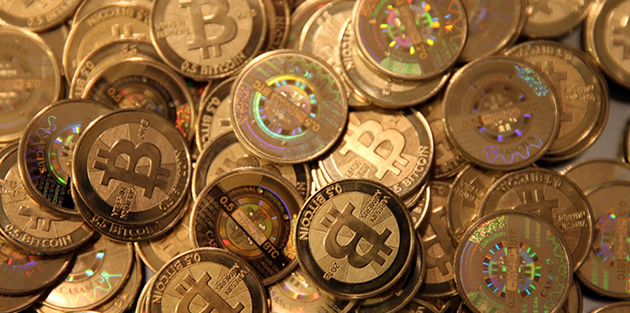Bitcoin: Currency of Currencies
Might fiat currency one day be denominated in bitcoin? by STEVE PATTERSON:
Bitcoin’s creation represents a watershed moment in monetary history. For the first time, a currency combines the strengths of commodity money with the convenience of fiat money, while avoiding the problems with both. Bitcoin is a new type of currency created for a new type of world: the digital world. And as more people trust bitcoin, it has the potential to completely overturn the established financial system.
Around the globe, nearly everybody uses fiat money — paper currency not redeemable in anything. But this wasn’t always the case. With few exceptions, paper emerged as a popular currency for a specific reason: it was redeemable in precious metals. Only recently has this not been the case. This concept of redeemability, when applied to bitcoin, suggests that history might repeat itself in a big way.
For the last millennium, a key storyline in the history of money has been the relationship between precious metals and paper. Gold, silver, and paper have all been used as currencies. At times, precious metals were used directly as currency; circulating coins were stamped in gold or silver. At other times, paper bills were used as currency — either redeemable in gold or silver, or not backed by anything at all.
Given enough time, all experiments with fiat paper money have ended in failure. So I want to focus on the success story: paper currency, redeemable in precious metals, emerging as the dominant form of money. How did it happen?
The story goes like this: several centuries ago, gold and silver were the most popular currencies in the Western world. (For the sake of brevity, I will refer to “gold and silver” as just “gold” in this article.) People often stored their gold in vaults with goldsmiths to keep it safe. On depositing their gold, they would be issued a paper receipt, which they could redeem on demand — like a coat check at a fancy hotel.
So, if person A wanted to trade with person B, he could pick up his gold from a goldsmith and exchange it for whatever good or service he wanted with person B. Then, person B could take his new gold back to a goldsmith who would issue him a new receipt. Not the smoothest process, but it worked.
As you can imagine, people found a way to streamline this system. Instead of trading physical gold, person A could simply trade his paper receipt — his claim for the gold — to person B. That way, gold ownership transferred without the hassle of lugging physical gold around. The paper receipt was essentially as good as gold.
Person B could also now avoid carrying metal around by trading his paper receipt. He might exchange it with person C, who could turn around and trade it again with person D, and so on. Physical gold needed not actually circulate, unless people wanted to redeem their receipts for it. Thus, paper receipts emerged as a popular form of currency. And as I’ll argue in a moment, this system has huge implications for bitcoin.
In theory, under this system, the total supply of paper currency was limited by the amount of gold stored in vaults. But in practice, the goldsmiths would sometimes create fake receipts, not backed by anything; it’s called “fractional-reserve lending,” and it’s a topic for another time. The important part is this: the monetary system relied on trust placed in goldsmiths. You had to believe that the paper receipts were tied to something concrete — that they weren’t just created out of thin air.
Under this system, paper currency is valuable because it represents a claim to a finite amount of gold. If the supply of currency becomes unlimited, detached from the finite supply of gold, that currency eventually becomes worthless. The paper is no longer as good as gold; it’s only as good as paper, which isn’t very good at all. Unfortunately, this process of currency devaluation has happened dozens of times throughout history.
Governments have also denominated their currencies in relation to precious metals. For example, during half of the 20th century, one US dollar could officially be redeemed for 1/35th an ounce of gold. But, due to political mischief, the United States canceled its policy of redeemability during the 1970s, and the dollar has been a fiat currency ever since.
What does this have to do with bitcoin? Here’s my theory: the same phenomenon that happened with gold and paper can happen again with bitcoin and paper. The redeemability of bitcoin will give it incredible use as a currency. It’s more convenient to use than paper — just as paper is more convenient to use than gold — but unlike paper, it is inflation proof.
If that sounds like a bunch of abstract mumbo jumbo, here it is in more concrete terms: right now, people across the world are accepting bitcoin through payment processors like Bitpay, and they immediately convert their bitcoin into local currency. They might sell a product for 1 BTC, but they instantly redeem that bitcoin for, say, dollars, euros, or yen. It’s this process that I imagine will change in the future, with huge implications.
Naturally, people are redeeming their bitcoin right now because they’re unsure; it’s a new type of currency, and they don’t want to get stuck holding something worthless. But what happens when the fear and uncertainty around bitcoin diminish? If you know you can immediately redeem your bitcoin safely, the incentive to actually do so lessens. It’s like holding a goldsmith’s receipt; yes, you can go to the vault and get your gold, but it’s an unnecessary hassle when you could just hold on to the receipt instead.
Bitcoin is easier to transact than paper; you can send it anywhere on the planet. Plus, it is protected from counterfeiting, unlike paper money. And nobody has to worry about fractional-reserve bitcoin receipts — every bitcoin is publicly viewable by visiting the corresponding address on the blockchain. And, you, not a goldsmith, have final access to your bitcoin if you hold the keys. With all of these advantages, the incentive to redeem your bitcoin shrinks.
Here’s where it gets really exciting: if bitcoin is held as this sort of meta-currency, one feature cannot be overstated: it is inflation proof. Paper is way more convenient than gold, but it has a catastrophic Achilles’ heel: it can be printed out of thin air. Bitcoin is way more convenient than paper, and we don’t have to worry about its inflation. It merges super portability with super security. Historically speaking, no currency has ever existed with both of these properties.
And this convenience says nothing about the technical potential for bitcoin; keep in mind, bitcoin is software, and it can evolve even greater properties in the future. You can’t say that about gold.
Just as paper emerged on the back of gold, bitcoin might emerge on the back of paper. If redeeming bitcoin for local currency becomes superfluous, the monetary world might be turned on its head. Instead of denominating bitcoin in fiat currency, fiat currency might end up being denominated in bitcoin. After all, it was the connection with precious metals that protected paper currency from inflation and gave it significant appeal. And it could be argued that bitcoin has an even more strictly limited supply than precious metals.
It might sound idealistic, but bitcoin could represent the beginning of a new financial world built on a solid, digital, noninflationary foundation. As with the emergence of gold, silver, and paper as money, the market will ultimately decide which currency is best.
 ABOUT STEVE PATTERSON
ABOUT STEVE PATTERSON
Steve Patterson is a freelance motion graphics producer and writer. He is the creator of The Truth About… educational animation series. You can follow him at steve-patterson.com.



Trackbacks & Pingbacks
[…] Opinion: Might fiat currency someday be denominated in bitcoin? An excerpt: “Bitcoin’s creation represents a watershed moment in monetary history. For the first time, a currency combines the strengths of commodity money with the convenience of fiat money, while avoiding the problems with both. Bitcoin is a new type of currency created for a new type of world: the digital world. And as more people trust bitcoin, it has the potential to completely overturn the established financial system.” [Dr. Rich Swier] […]
Comments are closed.